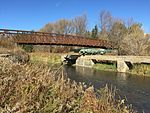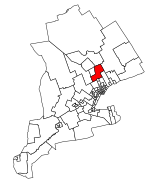The Newmarket Canal, officially known but rarely referred to as the Holland River Division, is an abandoned barge canal project in Newmarket, Ontario. With a total length of about 10 miles (16 km), it was supposed to connect the town to the Trent–Severn Waterway via the East Holland River and Lake Simcoe. Construction was almost complete when work was abandoned, and the three completed pound Locks, a swing bridge and a turning basin remain largely intact to this day.
The project was originally presented as a way to avoid paying increasing rates on the Northern Railway of Canada, which threatened to make business in Newmarket uncompetitive. The economic arguments for the canal were highly debatable, as the exit of the Waterway in Trenton was over 170 kilometres (110 mi) east of Toronto, while Newmarket was only 50 kilometres (31 mi) north of the city. Moreover, predicted traffic was very low, perhaps 60 tons a day in total, enough to fill two or three barges at most.
From the start, the real impetus for the project was a way to bring federal money to the riding of York North, which was held by powerful Liberal member William Mulock. That it was a patronage project was clear to all, and it was under constant attack in the press and the House of Commons. As construction started in 1908, measurements showed there was too little water to keep the system operating at a reasonable rate through the summer months. From then on it was heaped with scorn in the press and became the butt of jokes and nicknames, including "Mulock's Madness".The canal was one of the many examples of what the Conservative Party of Canada characterized as out-of-control spending on the part of the ruling Liberals. Their success in the 1911 federal election brought Robert Borden to power and changes at the top of the Department of Railways and Canals. They quickly placed a hold on ongoing construction, and a few weeks later, ended construction outright. Today, locals refer to it as "The Ghost Canal".






